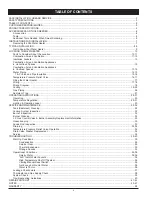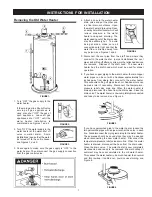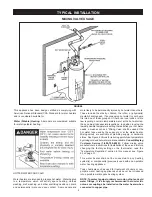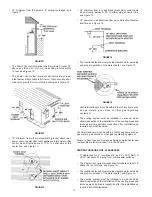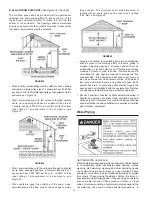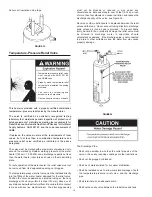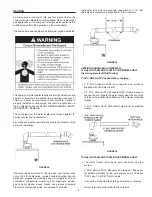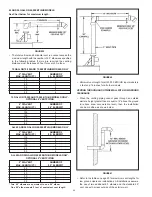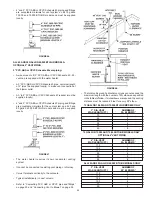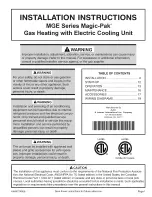
10
Facts to Consider About the Location
Carefully choose an indoor location for the new water heater,
because the placement is a very important consideration for
the safety of the occupants in the building and for the most
economical use of the appliance.
This water heater is not for
use in manufactured (mobile) homes or outdoor installation.
Whether replacing an old water heater or putting the water heater
in a new location, the following critical points must be observed:
•
The location selected should be indoors as close as practical
to the vent termination point, and as centralized with the water
piping system as possible. The water heater, as all water
heaters, will eventually leak. Do not install without adequate
drainage provisions where water flow will cause damage.
•
40,000 BTU/HR INPUT MODELS - If vented through an outside
wall or through the roof, the 3” vent piping cannot exceed a total
of 115 feet (50 feet if optional 2” vent piping is used), including
vertical and horizontal runs with one 90
o
elbow. If more elbows
are required, the venting distance must be reduced 5 feet for
every 90 elbow, see page 22 for vent chart.
•
70,000 and 75,000 BTU/HR INPUT MODELS -If vented through
an outside wall or through the roof, the 3” vent piping cannot
exceed a total of 70 feet (110 feet if optional 4” vent piping is
used), including vertical and horizontal runs with one 90
o
elbow.
If more elbows are required, the venting distance must be
reduced 5 feet fro every 90 elbow, see page 22 for vent chart.
•
Vent piping cannot slope downward and horizontal runs
require 1/8” per five foot rise. All horizontal runs require
adequate support at 3 1/2 foot intervals and vertical runs
supported at 5 foot intervals.
•
The water heater requires its own (separate) venting system.
It cannot be connected to an existing vent pipe or chimney. It
must terminate to the outdoors. Whenever possible terminate
the vent on the leeward side of the building if vented through
an outside wall.
NOTE: Condensation may be created, at times,
as the combustion gases exit the vent cap and discoloration
of surfaces in proximity to the vent cap may occur.
The power vent water heater requires its own (separate) venting
system. It cannot be connected to an existing vent pipe or
chimney. It must be terminated to the outdoors. Failure to properly
install the venting system can result in asphyxiation, a fire or
explosion and can cause DEATH, SERIOUS BODILY INJURY,
OR PROPERTY DAMAGE.
•
The water heater comes equipped with a 7 foot power cord
which can be used to connect to a 110/120 volt power source
if (1) local codes allow, and (2) there is a three prong receptacle
available.
This unit must have a grounded outlet to operate.
Do not use an extension cord. If there is not a suitable
receptacle and/or local codes prohibit use of a power cord,
field wiring must be provided.
Installation of the water heater must be accomplished in such a
manner that if the tank or any connections should leak, the flow
will not cause damage to the structure. For this reason, it is not
advisable to install the water heater in an attic or upper floor.
When such locations cannot be avoided, a suitable drain pan
should be installed under the water heater. Drain pans are
available at your local hardware store. Such a drain pan must
have a minimum length and width of at least 2 inches (51 mm)
greater that the water heater dimensions and must be piped to
an adequate drain. The pan must not restrict combustion air flow.
Water heater life depends upon water quality, water pressure
and the environment in which the water heater is installed. Water
heaters are sometimes installed in locations where leakage
may result in property damage, even with the use of a drain pan
piped to a drain. However, unanticipated damage can be reduced
or prevented by a leak detector or water shut-off device used in
conjunction with a piped drain pan. These devices are available
from some plumbing supply wholesalers and retailers, and
detect and react to leakage in various ways:
•
Sensors mounted in the drain pan that trigger an alarm or
turn off the incoming water to the water heater when leakage
is detected.
•
Sensors mounted in the drain pan that turn off the water supply
to the entire home when water is detected in the drain pan.
•
Water supply shut-off devices that activate based on the
water pressure differential between the cold water and hot
water pipes connected to the water heater.
•
Devices that will turn off the gas supply to a gas water heater
while at the same time shutting off its water supply.
LOCATING THE NEW WATER HEATER
Содержание HRN11240P
Страница 3: ...3 SAFETY PRECAUTIONS ...
Страница 45: ...45 NOTES ...
Страница 46: ...46 NOTES ...
Страница 47: ...47 NOTES ...




